Keeping your car’s Continuously Variable Transmission (CVT) fluid in check is key for its performance and life. Knowing how to check the CVT fluid level in your Nissan Altima is vital. This guide will show you how to do it, helping you avoid expensive repairs later.
Nissan stresses the need for CVT fluid maintenance. They suggest changing it every 30,000 miles, depending on how much you drive in the city. By following this guide, you’ll learn to keep your Altima’s CVT fluid at the right level.
Key Takeaways
- Regular CVT fluid maintenance is crucial for optimal performance and longevity of your transmission.
- Knowing how to check CVT fluid level Nissan Altima can help you save from costly repairs.
- Nissan recommends CVT fluid change based on various opinions, with some suggesting every 30,000 miles for city driving.
- CVT fluid check Altima is a relatively simple process that can be done at home.
- Using genuine NISSAN NS-3 fluid is recommended for CVT fluid change, which costs approximately $20 per quart.
- A recommended amount for a drain and refill is around 4 quarts for a Nissan Murano CVT.
Understanding Your Nissan Altima’s CVT System
Your Nissan Altima has a Continuously Variable Transmission (CVT). This system makes driving smooth and efficient. Unlike old automatics, CVTs adjust to the best gear ratio for better fuel use and driving.
What is a CVT Transmission?
A CVT uses pulleys and belts for an endless range of gear ratios. This lets the engine run at its best RPM. This improves fuel economy and speed compared to old transmissions.
Why CVT Fluid is Critical
Keeping the Altima CVT transmission fluid level right is key for your car’s transmission. The right fluid levels stop wear and overheating. This avoids expensive fixes and keeps your drive smooth.
Types of CVT Fluid for Nissan Altima
For good Nissan Altima CVT maintenance, use the right CVT fluids. Nissan has different fluids for different years and engines. The correct fluid keeps your transmission running well and lasts longer.
| Model | Year Range | CVT Fluid Level | Handle Color |
|---|---|---|---|
| Altima | 2013-2018 | 14mm to 30mm | Red |
| Maxima | 2016-2019 | 14mm to 22mm | Red |
| Murano | 2015-2019 | 14mm to 22mm | Red |
| Pathfinder | 2013-2019 | 14mm to 22mm | Red |
| Rogue (US/Japan) | 2014-2019 | 44mm to 51mm | Blue |
| Rogue (Korea) | 2015-2019 | 50mm to 57mm | Blue |
| Rogue Sport | — | 10mm to 17mm | Blue |
| Sentra (Turbo) | 2017-2019 | 10mm to 17mm | Blue |
Important Safety Precautions Before Starting
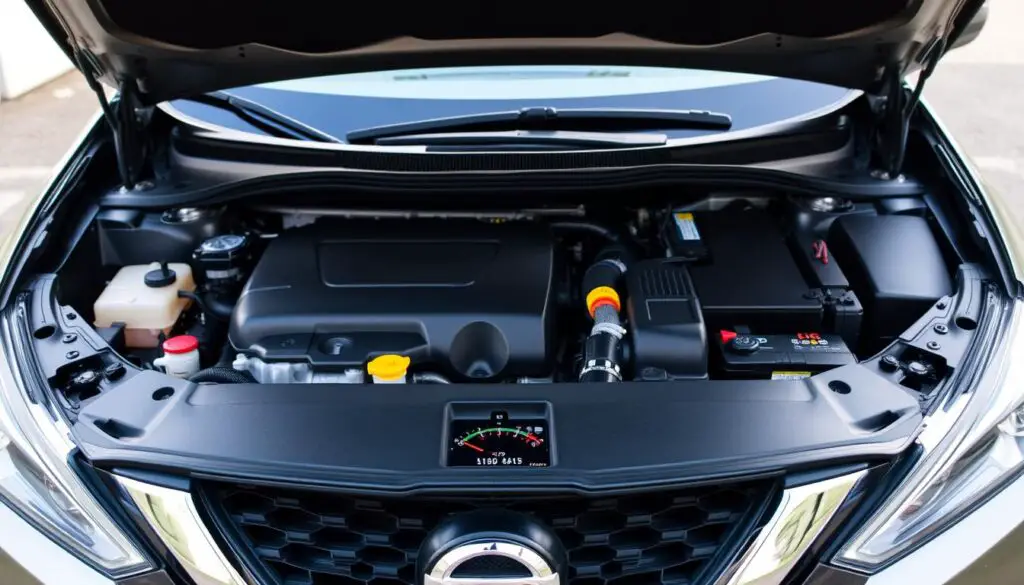
Before you start checking the fluid levels in your Nissan Altima, make sure you’re safe. Park your car on a flat surface. This keeps it stable while you check the CVT fluid.
It’s crucial to engage the parking brake. This keeps the car from moving. If the engine was running, wait at least 15 minutes for it to cool down. A cool engine is safer and gives you accurate readings.
- Park on a level surface to ensure the vehicle remains steady.
- Engage the parking brake to prevent the car from moving.
- Let the engine cool if it has been running recently.
- Wear protective gloves to safeguard your hands from hot surfaces and fluids.
- Use safety goggles to protect your eyes from potential splashes.
By following these steps, you keep yourself safe and make the maintenance easier.
| Safety Precaution | Purpose |
|---|---|
| Park on a level surface | Ensures stability during inspection |
| Engage the parking brake | Prevents accidental movement |
| Allow engine to cool | Reduces risk of burns and ensures accurate fluid levels |
| Wear protective gloves | Protects hands from hot fluids and surfaces |
| Use safety goggles | Shields eyes from potential splashes |
Required Tools and Materials
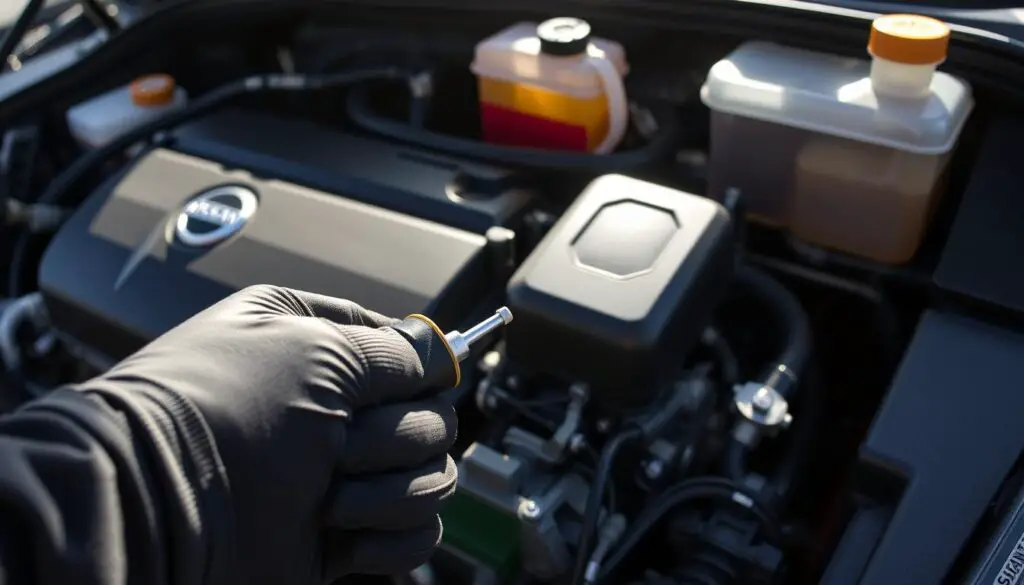
Getting ready right is key for a smooth Nissan Altima transmission fluid level check. Make sure you have all the tools and materials before starting. This will make the job easier.
Essential Tools Checklist
- Clean rag: For wiping excess fluid and keeping the work area clean.
- Funnel: To prevent spills when adding or checking fluid.
- Padded gloves: To protect your hands during the process.
- J-51155 tool or a 23 ⅛ dipstick: For accurate fluid level measurements.
Recommended Fluid Types
- NS-3 rated CVT fluid: Suitable for Nissan Altima models 2013 and newer.
- JF016E CVT fluid: Recommended for optimal performance and longevity.
Additional Equipment Needed
- Transmission fluid pan: To capture any spills during the check.
- Torque wrench: Ensures accurate tightening of dipstick and filler components.
- Safety goggles: Protect your eyes from any accidental splashes.
| Category | Items |
|---|---|
| Essential Tools | Clean rag, Funnel, Padded gloves, J-51155 tool or 23 ⅛ dipstick |
| Recommended Fluids | NS-3 rated CVT fluid, JF016E CVT fluid |
| Additional Equipment | Transmission fluid pan, Torque wrench, Safety goggles |
Preparing Your Vehicle for Fluid Check

Before starting the Altima CVT fluid inspection tutorial, make sure your Nissan Altima is ready. Proper preparation is key for an accurate check and to keep your CVT system healthy.
Park your vehicle on a level surface. This ensures the fluid level readings are accurate. Uneven ground can cause errors.
Let the engine warm up. A warm engine means the CVT fluid is at the right viscosity. This is crucial for a correct fluid level check in your Altima.
Shift through all the gear positions. This helps circulate the CVT fluid. It gives you a true measurement when checking the fluid level in your Altima.
How to Check CVT Fluid Level Nissan Altima
Regular CVT fluid check Altima is key for your Nissan Altima’s transmission health. Keeping the fluid level right can avoid expensive repairs and make your car last longer.
Engine Temperature Requirements
Warm up the engine for a few minutes before checking the fluid. This makes sure the CVT fluid is at the right temperature. This gives you an accurate reading during the Nissan Altima fluid level inspection.
Locating the CVT Dipstick
The CVT dipstick is usually to the right of the oil dipstick in front-wheel-drive Altima models. If you can’t find it, check your owner’s manual for exact location.
Reading Fluid Levels Accurately
To check the fluid level:
- Pull out the dipstick and wipe it clean with a cloth.
- Reinsert the dipstick fully and then remove it again.
- Check the fluid level against the “Full” and “Low” markings.
- If the level is below “Full,” use a funnel to add the recommended CVT fluid.
| Step | Action | Indicator |
|---|---|---|
| 1 | Warm up the engine | Engine at operating temperature |
| 2 | Locate and remove the CVT dipstick | Dipstick clean and dry |
| 3 | Reinsert and remove the dipstick | Fluid level between “Full” and “Low” |
| 4 | Add fluid if necessary | Fluid reaches “Full” mark |
Interpreting CVT Fluid Condition
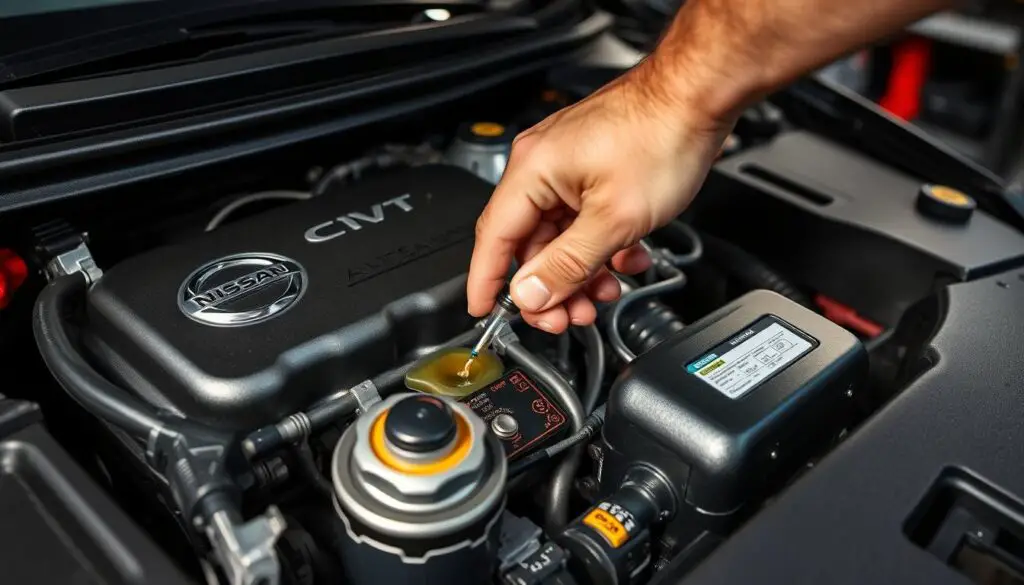
Knowing the Altima CVT transmission fluid level is key for Nissan Altima CVT maintenance. The fluid’s state shows how well your transmission is doing.
Good CVT fluid is clear or a bit pink and smells sweet. It should be clean and smooth, without any bits in it.
But, if the fluid looks different, smells off, or feels odd, it might mean trouble:
- Dark or Brown Fluid: Shows oxidation and possible breakdown.
- Burnt Smell: Means it’s overheated and might be dirty.
- Milky Appearance: Could mean water got in.
By checking the Altima CVT transmission fluid level often and watching for these signs, you can tell if you just need to top it up or if you need a full change. Catching fluid problems early can save you from expensive repairs and keep your car running longer.
| Fluid Condition | Indicators | Recommended Action |
|---|---|---|
| Clear or Slightly Pink | Good condition, no issues detected. | Continue regular Nissan Altima CVT maintenance. |
| Dark or Brown | Oxidation or degradation. | Consider a fluid change. |
| Burnt Smell | Overheating or contamination. | Immediate fluid change recommended. |
| Milky Appearance | Water contamination. | Flush and replace the fluid. |
Common Signs of Low CVT Fluid
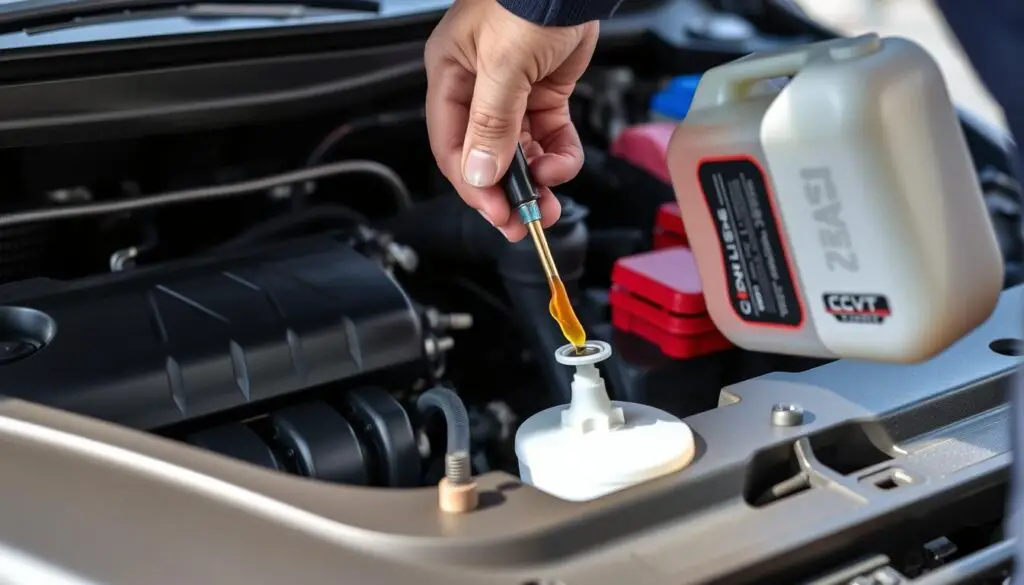
It’s important to check your Altima’s CVT fluid regularly. Low fluid levels can cause big problems with your transmission.
Transmission Performance Issues
Low CVT fluid can make your car feel jerky or slow to move. This means your transmission isn’t working right because it’s not getting enough fluid. It affects how well your car responds.
Warning Signals to Watch For
Watch for dashboard lights like the transmission temperature or check engine light. Strange noises, like whining or grinding, also mean something’s wrong with the CVT fluid.
Emergency Symptoms
Big problems like losing power or the transmission slipping are emergencies. You need to act fast to avoid serious damage to your transmission.
Proper CVT Fluid Filling Procedure
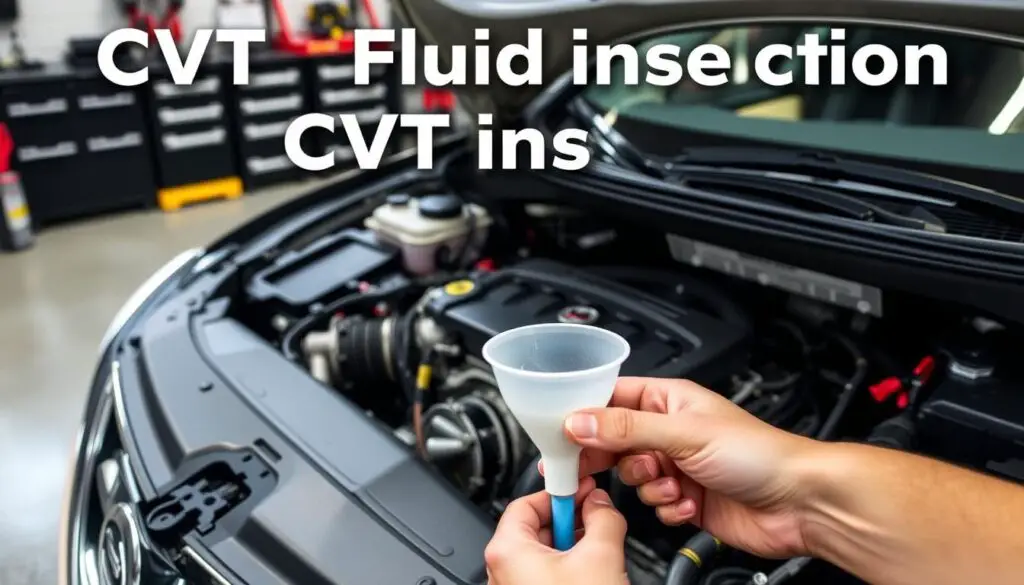
After checking the Nissan Altima transmission fluid level, it’s time to fill the CVT fluid. This step is crucial for your transmission to work well. The Altima CVT fluid inspection tutorial will guide you through this process.
Step-by-Step Guide
- Park your Altima on a level surface and engage the parking brake.
- Locate the CVT dipstick under the hood.
- Use a clean funnel to pour the recommended Nissan CVT fluid into the transmission.
- Add fluid slowly to prevent overfilling, checking the level frequently.
- After adding the proper amount, remove the funnel and securely replace the dipstick.
- Start the engine and let it idle for a few minutes, then recheck the fluid level to ensure accuracy.
Avoiding Common Mistakes
- Overfilling the transmission can cause pressure build-up and potential leaks.
- Using the wrong type of fluid may damage the CVT and void the warranty.
- Neglecting to use a clean funnel can introduce contaminants into the transmission.
- Not checking the fluid level after filling can result in improper transmission function.
- Ignoring the manufacturer’s recommended fluid type and quantity can lead to serious transmission problems.
Maintaining Optimal CVT Fluid Levels

Keeping your CVT fluid at the right level is key for a smooth ride in your Nissan Altima. Regular CVT fluid check Altima helps avoid transmission problems and keeps your car running longer.
Many things can change CVT fluid levels. Extreme temperatures can make the fluid expand or shrink. Heavy driving, like towing or city traffic, also uses more fluid.
To keep your fluid levels just right, follow these tips:
- Do a How to check CVT fluid level Nissan Altima often, before long drives.
- Check the fluid every 30,000 miles or as your owner’s manual suggests.
- Watch for leaks or odd sounds that might mean the fluid is low.
- Change how often you check it based on how you drive and your car’s age.
Older cars or those driven hard might need more CVT fluid check Altima. Being ahead of maintenance can prevent expensive repairs later.
Troubleshooting CVT Fluid Issues

Even with regular checks, you might still face CVT fluid problems. Spotting and fixing these issues early can save your car from bigger damage.
Fluid Leaks
Fluid leaks are a common CVT problem. Look for puddles under your car or fluid on the ground. Leaks often show up around the transmission pan or fluid lines. Catching leaks early can prevent bigger problems.
Contamination Signs
Contaminated CVT fluid can make your car’s transmission act poorly. Check the fluid’s color and texture during your check-ups. If it’s dark or gritty, it’s contaminated and might need a change or more tests.
When to Seek Professional Help
If you see constant leaks or a lot of contamination, get a pro’s help. Experts can fix complex issues like transmission seals or internal parts. Trying to fix big problems yourself can make things worse.
| Issue | Symptoms | DIY Solution | When to Seek Professional Help |
|---|---|---|---|
| Fluid Leaks | Puddles under vehicle, low fluid | Tighten fluid lines or replace seals | Persistent leaks, internal leaks |
| Contaminated Fluid | Dark or gritty fluid, poor performance | Drain and replace fluid | Repeated contamination, internal damage |
| Overheating | Transmission overheating, erratic shifts | Check fluid level and condition | Persistent overheating, system failure |
CVT Fluid Change Intervals
Changing the CVT fluid at the right time is key for your Nissan Altima’s transmission. Following the recommended schedule helps avoid expensive repairs and keeps your car running well.
Manufacturer Recommendations
Nissan says the CVT fluid is for life, meaning you might not need to change it often. But, they suggest a premium upgrade every 30,000 miles for the best performance. This keeps your transmission in top shape and extends its life.
Severe Usage Considerations
If you drive your Altima a lot in tough conditions, like heavy traffic or extreme weather, you should check the CVT fluid more often. Changing it every 30,000 miles helps prevent damage and wear.
Experts agree that changing CVT fluid every 30,000 to 60,000 miles is best. This matches Nissan’s advice. Regular care boosts performance and reduces the chance of transmission problems, keeping your Altima reliable for years.
Impact of Climate on CVT Fluid
Climate is key when Checking CVT fluid on Nissan Altima. Extreme temperatures can change the fluid’s viscosity and effectiveness. This affects your car’s performance.
In hot weather, CVT fluid can break down. This makes it less effective at lubricating and protecting the transmission. On the other hand, cold weather can make the fluid thicker, leading to poor performance. It’s important to understand these effects for a proper Nissan Altima transmission fluid level check.
- Hot Climates: Change CVT fluid every 15k to 20k miles to prevent breakdown.
- Cold Climates: Ensure fluid remains at optimal viscosity for smooth shifting.
- Moderate Climates: Follow manufacturer’s recommended maintenance schedule.
Regular checks are crucial, more so in areas with extreme temperatures. Here’s a table with temperature ranges and maintenance tips:
| Temperature Range | Classification | Maintenance Tips |
|---|---|---|
| 120°F – 194°F (49°C – 90°C) | Safe | Regular fluid checks as per schedule. |
| 200°F – 210°F (90°C – 99°C) | Hot | Change fluid every 15k miles. |
| 220°F and above (110°C+) | Concerning | Pull over safely and allow cooling. |
Adjusting your maintenance routine for your local climate helps keep your Nissan Altima’s CVT system running well.
Cost Considerations for CVT Maintenance
Keeping your Nissan Altima’s CVT in good shape is a smart move. It can save you a lot of money in the long run. Knowing the costs helps you make better choices for your car’s care.
DIY vs Professional Service
Deciding between DIY and professional CVT maintenance depends on a few things:
- DIY: It’s cheaper upfront because you only need to buy tools and fluids. You can follow the Altima CVT fluid inspection tutorial at your own pace.
- Professional Service: It’s pricier, but pros do the job right. They use the right fluids and know how to fix complex problems.
Let’s look at the costs:
| Service Type | Average Cost | Pros | Cons |
|---|---|---|---|
| DIY | $100 – $150 | Lower cost, flexible timing | Requires tools and knowledge |
| Professional | $350 – $400 | Expertise, warranty on service | Higher cost |
Long-term Savings Benefits
Regular CVT care can save you from big repair bills later. By checking the CVT fluid level as shown in the how to check CVT fluid level Nissan Altima guide, you keep your car running smoothly. This also makes your car last longer.
- Prevents major transmission issues like gear slippage.
- Reduces the risk of entering limp mode, which can lead to further damage.
- Saves money by avoiding costly repairs and extending vehicle longevity.
Common Mistakes to Avoid
Keeping your Nissan Altima’s CVT in good shape is key. Avoiding common mistakes can help your transmission last longer.
One big mistake is using the wrong CVT fluid. Always check your owner’s manual for the right one. The wrong fluid can harm your transmission.
- Overfilling the transmission: Too much fluid can cause high pressure. This can lead to leaks and damage to parts.
- Neglecting regular checks: Skipping CVT fluid checks can let low levels go unnoticed. This can harm your transmission over time.
- Ignoring fluid condition: If the fluid looks dark or burnt, it’s contaminated. Catching this early with a Nissan Altima fluid level inspection is crucial.
To avoid these problems, make sure to schedule regular inspections. Following the maintenance guidelines is also important. This way, your Altima’s CVT will run smoothly and efficiently.
Expert Tips for CVT Longevity
Keeping the right Altima CVT transmission fluid level is key for your Nissan Altima’s performance. It’s not just about checking the fluid. There are other ways to make your CVT last longer.
Preventive Maintenance Strategies
- Regularly check the Altima CVT transmission fluid level for best performance.
- Stick to the Nissan Altima CVT maintenance schedule. Change the fluid every 60,000 miles.
- Look for leaks in the transmission system and fix them quickly to avoid big repairs.
Driving Habits That Protect Your CVT
- Don’t make sudden starts or harsh stops to lessen the CVT’s strain.
- Let the transmission fully engage before speeding up from a stop for smoother shifts.
- Drive at moderate speeds and don’t overload your car to prevent too much wear on the CVT.
Conclusion
Keeping your Nissan Altima’s CVT in good shape is key for smooth driving. By following the steps in this guide, you can keep your transmission running well. Regular checks of the CVT fluid help avoid problems and make your car last longer.
Don’t forget, checking CVT fluid is an ongoing task. Stick to the recommended change times—every 60,000 miles or sooner if you tow or drive on rough roads. Using the right Nissan NS-2 CVT fluid is also important to prevent damage.
Being proactive with CVT care means better driving and more peace of mind. Make sure to include these steps in your car’s maintenance routine. This way, your Nissan Altima will keep running smoothly for many years.
FAQ
How do I check the CVT fluid level in my Nissan Altima?
What type of CVT fluid is recommended for the Nissan Altima?
How often should I perform a CVT fluid check on my Altima?
What are the common signs of low CVT fluid in a Nissan Altima?
How can I interpret the condition of my Altima’s CVT fluid?
What is the proper procedure for filling CVT fluid in the Nissan Altima?
What tools and materials do I need to check the CVT fluid level on my Altima?
When should I seek professional help for my Nissan Altima’s CVT fluid issues?
What are the common mistakes to avoid when checking CVT fluid on a Nissan Altima?
How does climate affect the CVT fluid in my Nissan Altima?
What are the cost benefits of regularly maintaining CVT fluid in my Altima?
How long does CVT fluid last in a Nissan Altima, and when should it be changed?
What preventive maintenance strategies can help maximize the lifespan of my Altima’s CVT?
Can I check the CVT fluid level in my Nissan Altima without a dipstick?
What should I do if my Altima’s CVT fluid level is consistently low?

Jack Thompson is a writer and seasoned auto mechanic with over 15 years of experience in the automotive industry. Known for his expertise in vehicle mechanics, Jack has a deep understanding of car and truck systems. His skills, honed through years of hands-on experience, have made him a trusted name in the field. Jack is committed to providing valuable insights into car maintenance and repair, helping vehicle owners keep their vehicles in top condition.

